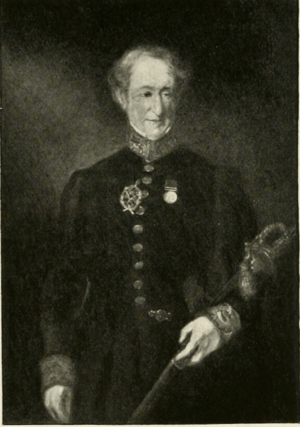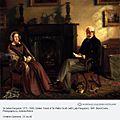Adam Ferguson (British Army officer) facts for kids
Quick facts for kids
Sir Adam Ferguson
|
|
|---|---|

Sir Adam Ferguson wearing his Peninsular war medal with Salamanca clasp.
|
|
| Born | 21 December 1770 |
| Died | 23 December 1854 |
| Allegiance | United Kingdom |
| Rank | Captain |
Sir Adam Ferguson (1770–1854) was a Scottish soldier and a very close friend of the famous writer Sir Walter Scott. He was also the deputy keeper of the Scottish crown jewels.
Contents
Life of Sir Adam Ferguson
Adam Ferguson was born on December 21, 1770. He was the first son of Professor Adam Ferguson.
Early Years and Friendship with Walter Scott
Adam Ferguson went to the Royal High School, Edinburgh in 1777. Later, he attended the University of Edinburgh. At both schools, he became good friends with Walter Scott. This friendship grew very strong and lasted until Scott's death in 1832.
People often said that Sir Adam Ferguson was one of Scott's funniest and kindest friends. He was great at mimicking people and always had a happy mood. Scott himself wrote about Ferguson's good nature. For example, in 1819, Scott recommended Ferguson to be a personal secretary for the 4th Duke of Buccleuch.
Ferguson was also one of the first members of a special club. This club was known for enjoying oysters, wine, and rum punch. In 1793, Ferguson and Scott explored parts of Perthshire. Scott later wrote about these places in his famous poems and stories.
In 1797, Ferguson went with Scott to the Lake District. One evening, they both dressed in their military uniforms. They had recently joined The Royal Edinburgh Volunteers. That night, they met Scott's future wife, Charlotte Carpenter. Joining the Volunteers helped shape Ferguson's future in the army.
Joining the Army
In the early 1800s, Adam Ferguson joined the army. He became an ensign (a junior officer) in 1805. He served in the 21st Regiment of Foot in Scotland and Ireland. In 1806, he became a lieutenant in the 34th Regiment, serving in Jersey.
He was promoted to captain in the 58th Regiment in February 1808. He served in Jersey before going to Portugal in July 1809.
Service in the Peninsular War
Captain Ferguson fought in the Peninsular War under the famous general, the 1st Duke of Wellington. He led a company of about 58 soldiers from the 58th Regiment of Foot.
His battalion was first based in Lisbon to protect the city. Later, they moved north to the Lines of Torres Vedras. These were strong defensive lines built to protect Lisbon. While protecting "The Lines," Ferguson wrote a letter to Scott. He described reading Scott's poem, The Lady of the Lake, to his soldiers while under cannon fire.
In April 1812, his regiment took part in the Battle of Salamanca. For his bravery in this battle, he later received a special clasp on his Peninsular War medal.
Prisoner of War
Ferguson was captured during Wellington's retreat from Burgos in late 1812. He was held prisoner in a town in France. He was not released until the war ended in 1814. Even though he faced hardships as a prisoner, he received some special treatment. This was because his father's cousin was Joseph Black M.D., a famous chemist.
After his release, he was put on half-pay in 1816. He was then assigned to the 101st Regiment.
Life with Sir Walter Scott
In the summer of 1817, Ferguson joined Scott on a trip to the Lennox. They wanted to visit Rob Roy's cave at Loch Lomond.
The next year, Ferguson and his sisters moved into a house Scott had bought. Scott named it Huntlyburn at the ladies' request. On August 19, 1818, Ferguson was given an important job. Thanks to Scott's efforts, he became the keeper of the Scottish Regalia. These are the crown jewels of Scotland, which had only recently been found again.
Around this time, Ferguson asked Sir David Wilkie to paint the Scott family. The painting is called The Abbotsford Family. In it, Scott and his family look like peasants. Ferguson is shown as a gamekeeper or poacher. You can see him standing to the right of Scott, with a feather in his cap.
In 1819, Ferguson traveled to Lisbon as a secretary. He went with Scott's friend, the 4th Duke of Buccleuch, who was not well.
In 1821, Adam Ferguson married Margaret Stewart. She was the widow of George Lyon. They lived at Gattonside House for a few years. When King George IV visited Scotland in 1822, Ferguson was knighted. This happened at Hopetoun House on August 29, 1822. Later, Sir Adam and Lady Ferguson moved back to Huntlyburn, living there from about 1826.
Later Life and Death
Between 1847 and 1852, Sir Adam Ferguson lived at 27 George Square, Edinburgh. He and his wife are shown in a painting from this time by David Cooke Gibson.
Sir Adam Ferguson died on December 25, 1854. He was buried on January 1, 1855. His grave is in the Covenanter's Prison section of Greyfriars Kirkyard in Edinburgh. His wife, Margaret Stewart, is buried with him.
Paintings and Memorials
Images for kids
See Also









